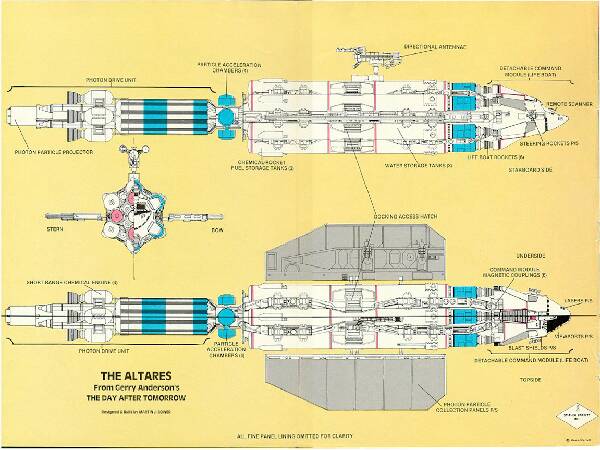The Altares
By DAVID HIRSCH
Starlog 58, May 1982. Scanned by Paulo Jorge Morgado
The Altares, a photon-powered, deep space probe ship, made its first appearance in the one-hour NBC-TV special The Day After Tomorrow. As the third segment of the NBC series Special Treat, it was designed to introduce the concepts of Einstein's theory of relativity to young people in the same entertaining format as the other segments (see STARLOG #26 for the full story on the making of this special. The plot of the program centered on two families who leave Earth on an exploratory mission aboard a craft that can travel just below the speed-of-light. The Altares is also equipped with chemical-rocket engines for close planetary surveys.
The interior of the ship was designed by Reg Hill, who co-created the popular UFO TV series. As seen in the film, the interior is a series of five rooms linked together in a straight line by a central corridor. The first section is the command deck from which the Altares is piloted. Next is the navigation and computer section, followed by the area containing the airlock, stowage rack and two bunks. The fourth section is used both as a lab and relaxation bay. There are also two more bunks in this section. The final part of the Altares is the photon-drive chamber, which is seen in the show when the pilot must go inside to repair the system.
Through the sale of stock footage, the Altares is currently appearing on theater screens across the U.S. in the low-budget comedy film Spaced-Out.
While working on the first season of Space: 1999, Martin J. Bower was asked by special effects designer Brian Johnson to create an Earth-type spacecraft with dual drive units that would carry a family into deep space. For Space: 1999, a style was established for all Earth-type ships seen in the series. This style, it was reasoned, would give viewers the impression that craft such as the Eagle, Hawk, Ultra Probe, etc., were all from the same culture. In turn, alien craft would look all the more unusual.
Having not been told that the Altares wasn't for Space: 1999, Bower designed the spacecraft to resemble the others he built and/or designed for the series. Reasoning the ship might be required to land, he built the nose cone as a removable unit. Once in orbit, the nose could detach and descend to the planet. Landing skids would drop from their hidden compartments prior to touch-down.
Bower delivered two versions of the Altares to the studio, one six-feet in length and the other, three-feet long, was built in scale with a space station and used for long- shots. (Note: The "Directional Antennae" seen in the blueprint was added on later at the studio and was not built by Martin Bower, which is why it is not seen in the accompanying photos. [The antennae was actually a Moonbase Alpha forcefield tower])
Martin J. Bower has been building models most of his life. Having grown up on such Gerry Anderson productions as Supercar, Stingray and Thunderbirds, it was a dream come true when, after sending photos of some of his models to Anderson, he was introduced to Brian Johnson, shortly after the special-effects man started work on the first season of Space: 1999. Impressed by the quality of Bower's work, Johnson offered the young model-maker the job of-designing and building an alien spacecraft for the episode "Alpha Child." Bower's professional film career was off and running. He would build as many as 58 models for 1999, many from his own designs.
Since that time, he has worked on the television programs Blake's 7, Mrs. Noah, The Tomorrow People, Doctor Who and the aborted Dan Dare series. Bower has also been involved in such feature films as ALIEN, Flash Gordon, The Medusa Touch and Outland. (For further information on the work and career of Martin Bower, see STARLOG issues 29, 30, 41, 44 and 47. [or follow this link)
Stephen Corbett's interest in model making eventually required him to develop the skills necessary to create scale drawings. These blueprints would be used as guidelines in the construction of scale replica miniatures. Corbett's fascination with the model work of Martin Bower led to a meeting between the two men. Bower agreed to help Corbett gather together original photographs and artwork in an effort to blueprint every one of Bower's Space: 1999 models. This art would provide Bower with a permanent record of his work and Corbett with the guidelines he needed to build accurate replicas.
Besides SF craft, Corbett is also fascinated by genuine space hardware and, whenever possible, he has extended his range of drawings to include this material. An active member of the North East Aircraft Museum in England, Corbett spends the rest of his free time involved in aviation archeology.
[Captioned Photos]
STARLOG/May 1982
